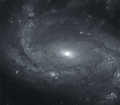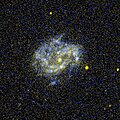NGC 4051
Appearance
| NGC 4051 | |
|---|---|
 Hubble image of NGC 4051 | |
| Observation data (J2000 epoch) | |
| Constellation | Ursa Major |
| Right ascension | 12h 03m 09.686s[1] |
| Declination | +44° 31′ 52.54″[1] |
| Redshift | 0.002336[2] |
| Heliocentric radial velocity | 700 km/s[2] |
| Distance | 45.14 ± 9.85 Mly (13.840 ± 3.021 Mpc)[2] |
| Group or cluster | Ursa Major Cluster |
| Apparent magnitude (V) | 12.92[3] |
| Apparent magnitude (B) | 11.08[3] |
| Characteristics | |
| Type | SAB(rs)bc[2] |
| Size | 78,800 ly (24,160 pc)[2][note 1] |
| Apparent size (V) | 6.00′ × 4.98′[2][note 1] |
| Other designations | |
| UGC 7030, MGC+08-22-059, PGC 38068[3] | |
NGC 4051 is an intermediate spiral galaxy in the constellation of Ursa Major.[2] It was discovered on 6 February 1788 by John Herschel.[4]
NGC 4051 contains a supermassive black hole with a mass of 1.73 million M☉.[5] This galaxy was studied by the Multicolor Active Galactic Nuclei Monitoring 2m telescope.[6] Several supernovae have been discovered in NGC 4051: SN 1983I, SN 2010br, and SN 2003ie.[3]
The galaxy is a Seyfert galaxy that emits bright X-rays. However, in early 1998 the X-ray emission ceased as observed in by the Beppo-SAX satellite.[7]
NGC 4051 is a member of the Ursa Major Cluster.[8][9][10]
Gallery
-
Hubble image of NGC 4051
-
NGC 4051 imaged by GALEX
-
RGB image of the galaxy NGC 4051 by the earthbound Liverpool Telescope
References
- ^ a b Skrutskie, M. (2006). "The Two Micron All Sky Survey (2MASS)". The Astronomical Journal. 131 (2): 1163–1183. Bibcode:2006AJ....131.1163S. doi:10.1086/498708.
- ^ a b c d e f g "NED results for object NGC 3697". National Aeronautics and Space Administration / Infrared Processing and Analysis Center. Retrieved 9 November 2017.
- ^ a b c d "NGC 4051". SIMBAD. Centre de données astronomiques de Strasbourg. Retrieved 9 November 2017.
- ^ "New General Catalog Objects: NGC 4050 - 4099". cseligman.com. Retrieved 9 November 2017.
- ^ Denney, K. D.; Watson, L. C.; Peterson, B. M.; Pogge, R. W.; Atlee, D. W.; Bentz, M. C.; Bird, J. C.; Brokofsky, D. J.; Comins, M. L.; Dietrich, M.; Doroshenko, V. T.; Eastman, J. D.; Efimov, Y. S.; Gaskell, C. M.; Hedrick, C. H.; Klimanov, S. A.; Klimek, E. S.; Kruse, A. K.; Lamb, J. B.; Leighly, K.; Minezaki, T.; Nazarov, S. V.; Petersen, E. A.; Peterson, P.; Poindexter, S.; Schlesinger, Y.; Sakata, K. J.; Sergeev, S. G.; Tobin, J. J.; Unterborn, C. (2009). "A revised broad-line region radius and black hole mass for the narrow-line Seyfert 1 NGC 4051". The Astrophysical Journal. 702 (2): 1353–1366. arXiv:0904.0251. Bibcode:2009ApJ...702.1353D. doi:10.1088/0004-637X/702/2/1353.
{{cite journal}}: Unknown parameter|displayauthors=ignored (|display-authors=suggested) (help) - ^ Suganuma, Masahiro; Yoshii, Yuzuru; Kobayashi, Yukiyasu; Minezaki, Takeo; Enya, Keigo; Tomita, Hiroyuki; Aoki, Tsutomu; Koshida, Shintaro; Peterson, Bruce A. (2006). "Reverberation Measurements of the Inner Radius of the Dust Torus in Nearby Seyfert 1 Galaxies". The Astrophysical Journal. 639 (1): 46–63. arXiv:astro-ph/0511697. Bibcode:2006ApJ...639...46S. doi:10.1086/499326. ISSN 0004-637X.
- ^ "Now you se it ...". New Scientist (2145): 23. 1 August 1998.
- ^ Tully, R. Brent; Verheijen, Marc A. W.; Pierce, Michael J.; Huang, Jia-Sheng; Wainscoat, Richard J. (December 1996). "The Ursa Major Cluster of Galaxies.I.Cluster Definition and Photometric Data". The Astronomical Journal. 112: 2471. arXiv:astro-ph/9608124. Bibcode:1996AJ....112.2471T. doi:10.1086/118196. ISSN 0004-6256.
- ^ P. Fouque, E. Gourgoulhon, P. Chamaraux, G. Paturel; Gourgoulhon; Chamaraux; Paturel (1992). "Groups of galaxies within 80 Mpc. II - The catalogue of groups and group members". Astronomy and Astrophysics Supplement. 93: 211–233. Bibcode:1992A&AS...93..211F.
{{cite journal}}: CS1 maint: multiple names: authors list (link) - ^ "The Ursa Major Groups". www.atlasoftheuniverse.com. Retrieved 2018-04-20.
Notes
External links
Wikimedia Commons has media related to NGC 4051.
- NGC 4051 on WikiSky: DSS2, SDSS, GALEX, IRAS, Hydrogen α, X-Ray, Astrophoto, Sky Map, Articles and images
- SN 2010br located 19".5 east and 10" south of the center at 12 03 10.96 +44 31 42.8 / Wikisky DSS2 zoom-in of same region



